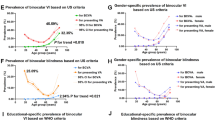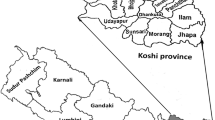Abstract
Objective
This study determined the prevalence and aetiology of unilateral visual impairment (VI) and blindness and its associated factors in school children.
Methods
We conducted a multistage, cross-sectional study in primary and secondary schools of Saki-East Local Government Area of Oyo State, Nigeria. Unilateral VI was defined as presenting visual acuity (PVA) worse than +0.3 LogMAR (6/12) and unilateral blindness as PVA worse than +1.3 LogMAR (3/60) in the worse eye. Detailed ocular examinations were performed for students with unilateral VI, and Logistic regression analysis was performed to explore associations with independent variables.
Results
The mean age of participants was 11 ± 3.2 years. Thirty-six (0.98%) of 3671 children had unilateral VI, and fifteen children had unilateral blindness (0.41%), giving a combined prevalence of 1.39 ± 0.5%. History of ocular trauma was reported by 14 (27.5%) participants with unilateral VI and blindness. In addition, those with a history of ocular trauma were 6.5 times more likely to be blind or have a severe VI (95% CI 1.5–2.8) than those without a history of ocular trauma. Uncorrected refractive error was the major cause of unilateral VI in 26 (51%) participants, while traumatic cataract was the main cause of unilateral blindness seen in 5 (9.8%) participants, none of whom had a previous eye examination.
Conclusion
Fourteen per thousand school children had unilateral VI in this study; the major causes were refractive error and cataract, which are treatable. Ocular trauma was a significant risk factor for unilateral VI and blindness.
This is a preview of subscription content, access via your institution
Access options
Subscribe to this journal
Receive 18 print issues and online access
$259.00 per year
only $14.39 per issue
Buy this article
- Purchase on Springer Link
- Instant access to full article PDF
Prices may be subject to local taxes which are calculated during checkout
Similar content being viewed by others
Data availability
The datasets generated during and/or analysed during the current study may be available from the corresponding author on reasonable request.
References
World Health Organization. International Statistical Classification of diseases and related health problems - 11th revision [Internet]. 2019. Available from: https://icd.who.int/browse11/l-m/en#/http%3A%2F%2Fid.who.int%2Ficd%2Fentity%2F1103667651
World Health Organisation. International statistical classification of diseases and related health problems - 10th revision. 2010.
Bourne RRA, Steinmetz JD, Saylan M, Mersha AM, Weldemariam AH, Wondmeneh TG, et al. Causes of blindness and vision impairment in 2020 and trends over 30 years, and prevalence of avoidable blindness in relation to VISION 2020: The Right to Sight: An analysis for the Global Burden of Disease Study. Lancet Glob Health. 2021;9:e144–60.
Kilangalanga NJ, Nsiangani LN, Dilu AA, Moanda KA, Ilunga MJ, Makwanga ME, et al. Epidemiology of Childhood Blindness and Low Vision in Kinshasa–democratic Republic of the Congo. Ophthalmic Epidemiol. 2020;27:45–51.
Atowa UC, Hansraj R, Wajuihian SO. Visual problems: A review of prevalence studies on visual impairment in school-age children. Int J Ophthalmol. 2019;12:1037–43.
Rein DB, Wittenborn JS, Zhang P, Sublett F, Lamuda PA, Lundeen EA, et al. The Economic Burden of Vision Loss and Blindness in the United States. Ophthalmology. 2022;129:369–78.
Knight LSW, Ridge B, Staffieri SE, Craig JE, Prem Senthil M, Souzeau E. Quality of Life in Adults with Childhood Glaucoma: An Interview Study. Ophthalmol Glaucoma. 2022;5:325–36.
Tommila V, Tarkkanen A. Incidence of loss of vision in the healthy eye in amblyopia. Br J Ophthalmol. 1981;65:575–7.
Teoh LJ, Solebo AL, Rahi JS, Morton C, Allen L, McPhee D, et al. Visual impairment, severe visual impairment, and blindness in children in Britain (BCVIS2): a national observational study. Lancet Child Adolesc Health. 2021;5:190–200.
Wadhwani M, Vashist P, Singh S, Gupta V, Gupta N, Saxena R. Prevalence and causes of childhood blindness in India: A systematic review. Indian J Ophthalmol. 2020;68:311–5.
World Health Organization. WHO|Priority eye diseases [Internet]. Prevention of blindness and visual impairment. 2014 [cited 2021 Feb 22]. Available from: http://www.who.int/blindness/causes/priority/en/index3.html
Duke RE, Lewallen S, Courtright P. Estimated Prevalence of Monocular Blindness and Monocular Severe Visual Impairment in Children of Cross Rivers State, Nigeria. Niger. J Ophthalmol. 2019;22:66–8.
Bandrakalli P, Ganekal S, Jhanji V, Liang YB, Dorairaj S. Prevalence and causes of monocular childhood blindness in a rural population in southern India. J Pediatr Ophthalmol Strabismus. 2012;49:303–7.
Ezinne NE, Nnadi CJ, Mashige KP, Onoikhua EE. Causes of Childhood Blindness among Children Seen at the National Eye Centre, Kaduna, Nigeria. J Ophthalmic Clin Res. 2018;5:1–5.
Omolase CO, Aina AS, Omolase BO, Omolade EO. Causes of Blindness and Visual Impairment at the School for the Blind, Owo. Ann Ib Postgrad Med. 2008;6:49–52.
Gilbert C. Worldwide causes of blindness in children. Pediatric Ophthalmology: Current Thought and A Practical Guide. 2009;47–60.
Duke R, Faal H. Uniocular blindness among children in the Gambia. Port Harcourt Medical Journal. 2007;1:167–70.
El-sheikh HF, K.F T. Childhood Blindness in Saudi Arabia. Invest Ophthalmol Vis Sci. 2002;43:3846.
Yorston D. The global initiative vison 2020: The right to sight childhood blindness. Community Eye Health. 1999;12:44–5.
Ekpenyong BN, Naidoo K, Ndep A, Akpan M, Ekanem E. Prevalence and determinants of visual impairment amongst school-aged children in Southern Nigeria. Afr Vision and Eye Health. 2020;79:534.
Okoye O, Umeh RE, Ezepue FU. Prevalence of eye diseases among school children in a rural south-eastern Nigerian community. Rural Remote Health. 2013;13:2357.
Naing L, Winn T, Rusli BN. Practical Issues in Calculating the Sample Size for Prevalence Studies. Arch of Orofac Sci. 2006;1:9–14.
Ayanniyi AA, Mahmoud AO, Olatunji FO. Causes and prevalence of ocular morbidity among primary school children in Ilorin, Nigeria. Niger J Clin Pract. 2010;13:248–53.
Gilbert C, Foster A, Negrel A, Thylefors B. Childhood blindness: a new form for recording causes of visual loss in children. Bull World Health Organ. 1993;71:485–9.
Told R, Baratsits M, Garhöfer G, Schmetterer L. ETDRS (Early Treatment Diabetic Retinopathy Study)-Visus. Ophthalmologe. 2013;110:960–5.
Holladay JT. proper method for calculating average visual acuity. J Refract Surg. 1997;13:388–91.
Kanski J. Strabismus. Strabismus; section quoted is Amblyopia In: Bowling B, editor. Kanski’s clinical ophthalmology - a systematic approach. 8th ed. Sydney, Australia: Elsevier; 2016. p. 738.
Nkanga D, Dolin P. School Vision Screening programme in Enugu, Nigeria: Assessment of referral criteria for error of refraction. Niger J Ophthalmol. 1997;5:34–40.
Olarinde O, Sowemimo OA, Chuang TW, Chou CM, Olasanmi SO, Ikotun K, et al. Toxoplasma gondii infection: seroprevalence and associated risk factors for women of childbearing age in Osun State, Nigeria. Pathog Glob Health. 2022;116:59.
Karshima SN, Karshima MN. Human Toxoplasma gondii infection in Nigeria: A systematic review and meta-analysis of data published between 1960 and 2019. BMC Public Health. 2020;20:1–15.
Oyeyemi OT, Oyeyemi IT, Adesina IA, Tiamiyu AM, Oluwafemi YD, Nwuba RI, et al. Toxoplasmosis in pregnancy: a neglected bane but a serious threat in Nigeria. Parasitology. 2020;147:127–34.
Efunshile AM, Elikwu CJ, Jokelainen P. Toxoplasmosis–awareness and knowledge among medical doctors in Nigeria. PLoS One. 2017;12.
Ode SA, Jubril AJ, Emikpe BO. Awareness and habits of Nigerians towards toxoplasmosis and risk factors. PAMJ-OH. 2021;4:4.
Amendoeira MRR, Millar PR. Congenital toxoplasmosis: the importance of implementing clinical practice guidelines. Lancet Regional Health - Americas. 2021 Sep;1.
Aribaba O, Alabi A, Alabi A, Adenekan A, Onakoya A, Akinsola F. Training Teachers on Vision Screening for School Children in Low-Resource Setting in Southwest, Nigeria. Niger J Ophthalmol. 2019;27:17.
Tabansi PN, Anochie IC, Nkanginieme KEO, Pedro-Egbe CN, Coph FM. Evaluation of Teachers’ Performance of Vision Screening in Primary School Children in Port Harcourt. Niger J Ophthalmol. 2009;17:27–31.
Ugalahi M, Bekibele C, Ogundipe A. Utilization of Vision Corridor for Self-evaluation of Vision Among Secondary School Students in Igbo-Ora, Southwest Nigeria. Niger J Ophthalmol. 2021;29:39–44.
Kinengyere P, Kizito S, Kiggundu JB, Ampaire A, Wabulembo G, Kizito S. Burden, etiology and predictors of visual impairment among children attending Mulago National Referral Hospital eye clinic, Uganda. Afr Health Sci. 2017;17:877–85.
Monye HI, Ugalahi M, Olusanya B, Baiyeroju A. Spare the rod or spoil the eye? Corporal punishment-related eye injuries among children presenting to a tertiary hospital in South West Nigeria. Niger J Public Heal. 2018;3:27–32.
Oluwakemi AB, Kayode A. Corporal punishment-related ocular injuries in Nigerian children. J indian Assoc Pediatr Surg. 2007;12:76–9.
Ashaye AO. Traumatic Hyphaema: A report of 472 consecutive cases. BMC Ophthalmol. 2008;8:1–7.
Zelalem M, Abebe Y, Adamu Y, Getinet T. Prevalence of visual impairment among school children in three primary schools of Sekela Woreda, Amhara regional state, north-west Ethiopia. SAGE Open Med. 2019;7:1–8.
Rahi JS, Logan S, Timms C, Russell-Eggitt I, Taylor D. Risk, causes, and outcomes of visual impairment after loss of vision in the non-amblyopic eye: A population-based study. Lancet. 2002;360:597–602.
Universal Basic Education Commission. Digest of basic education statistics for public and private schools in Nigeria. Abuja; 2019 May.
Oyo State Bureau of Statistics, UNICEF. Situation of children and women in Oyo State - An atlas of social indicators. Ibadan; 2018 Dec.
Acknowledgements
Appreciation to Members of Faculty of the Department of Ophthalmology, University College Hospital, Ibadan for their critique of the research proposal.
Author information
Authors and Affiliations
Contributions
Folahan A. Ibukun: Conceptualisation, Methodology, Principal Investigator, Analysis, Writing – original draft preparation. Mary Ugalahi: Supervision, Conceptualization, Writing – reviewing and editing. Charles Bekibele: Supervision, Writing – reviewing.
Corresponding author
Ethics declarations
Competing interests
The authors declare no competing interests.
Additional information
Publisher’s note Springer Nature remains neutral with regard to jurisdictional claims in published maps and institutional affiliations.
Rights and permissions
Springer Nature or its licensor (e.g. a society or other partner) holds exclusive rights to this article under a publishing agreement with the author(s) or other rightsholder(s); author self-archiving of the accepted manuscript version of this article is solely governed by the terms of such publishing agreement and applicable law.
About this article
Cite this article
Ibukun, F.A., Ugalahi, M.O. & Bekibele, C.O. Unilateral visual impairment and blindness in school children – prevalence and aetiology in Saki-East LGA of Oyo State, Nigeria. Eye (2024). https://doi.org/10.1038/s41433-024-02960-2
Received:
Revised:
Accepted:
Published:
DOI: https://doi.org/10.1038/s41433-024-02960-2



